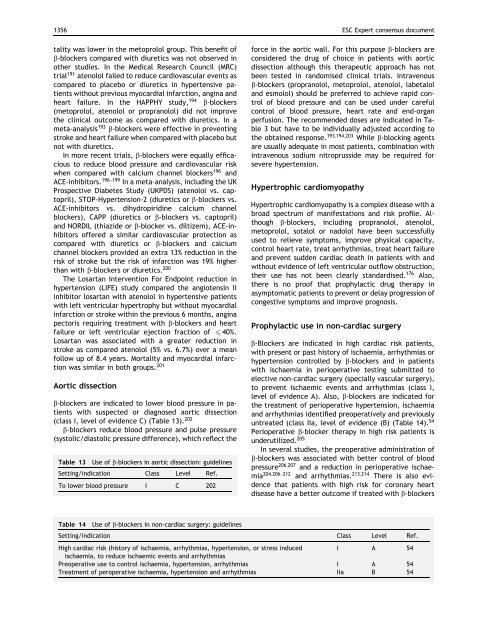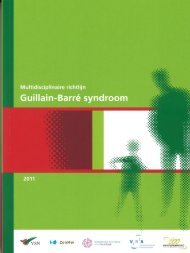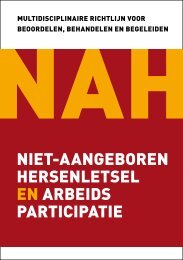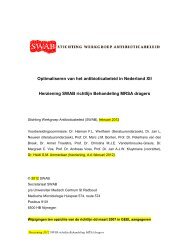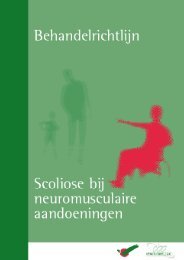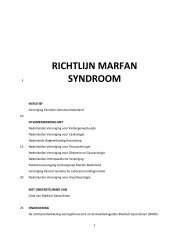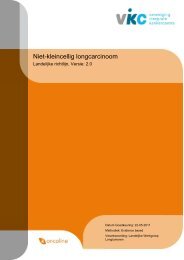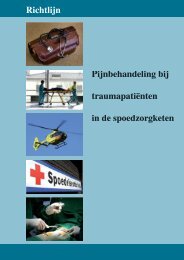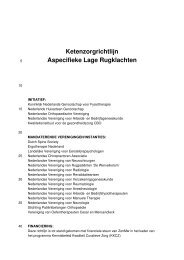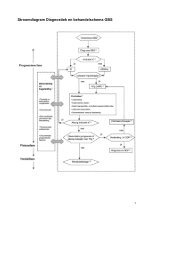Expert consensus document on b-adrenergic receptor blockers
Expert consensus document on b-adrenergic receptor blockers
Expert consensus document on b-adrenergic receptor blockers
You also want an ePaper? Increase the reach of your titles
YUMPU automatically turns print PDFs into web optimized ePapers that Google loves.
1356 ESC <str<strong>on</strong>g>Expert</str<strong>on</strong>g> <str<strong>on</strong>g>c<strong>on</strong>sensus</str<strong>on</strong>g> <str<strong>on</strong>g>document</str<strong>on</strong>g>tality was lower in the metoprolol group. This benefit ofb-<strong>blockers</strong> compared with diuretics was not observed inother studies. In the Medical Research Council (MRC)trial 191 atenolol failed to reduce cardiovascular events ascompared to placebo or diuretics in hypertensive patientswithout previous myocardial infarcti<strong>on</strong>, angina andheart failure. In the HAPPHY study, 194 b-<strong>blockers</strong>(metoprolol, atenolol or propranolol) did not improvethe clinical outcome as compared with diuretics. In ameta-analysis 193 b-<strong>blockers</strong> were effective in preventingstroke and heart failure when compared with placebo butnot with diuretics.In more recent trials, b-<strong>blockers</strong> were equally efficaciousto reduce blood pressure and cardiovascular riskwhen compared with calcium channel <strong>blockers</strong> 196 andACE-inhibitors. 196–199 In a meta-analysis, including the UKProspective Diabetes Study (UKPDS) (atenolol vs. captopril),STOP-Hypertensi<strong>on</strong>-2 (diuretics or b-<strong>blockers</strong> vs.ACE-inhibitors vs. dihydropiridine calcium channel<strong>blockers</strong>), CAPP (diuretics or b-<strong>blockers</strong> vs. captopril)and NORDIL (thiazide or b-blocker vs. diltizem), ACE-inhibitorsoffered a similar cardiovascular protecti<strong>on</strong> ascompared with diuretics or b-<strong>blockers</strong> and calciumchannel <strong>blockers</strong> provided an extra 13% reducti<strong>on</strong> in therisk of stroke but the risk of infarcti<strong>on</strong> was 19% higherthan with b-<strong>blockers</strong> or diuretics. 200The Losartan Interventi<strong>on</strong> For Endpoint reducti<strong>on</strong> inhypertensi<strong>on</strong> (LIFE) study compared the angiotensin IIinhibitor losartan with atenolol in hypertensive patientswith left ventricular hypertrophy but without myocardialinfarcti<strong>on</strong> or stroke within the previous 6 m<strong>on</strong>ths, anginapectoris requiring treatment with b-<strong>blockers</strong> and heartfailure or left ventricular ejecti<strong>on</strong> fracti<strong>on</strong> of 6 40%.Losartan was associated with a greater reducti<strong>on</strong> instroke as compared atenolol (5% vs. 6.7%) over a meanfollow up of 8.4 years. Mortality and myocardial infarcti<strong>on</strong>was similar in both groups. 201Aortic dissecti<strong>on</strong>b-<strong>blockers</strong> are indicated to lower blood pressure in patientswith suspected or diagnosed aortic dissecti<strong>on</strong>(class I, level of evidence C) (Table 13). 202b-<strong>blockers</strong> reduce blood pressure and pulse pressure(systolic/diastolic pressure difference), which reflect theTable 13 Use of b-<strong>blockers</strong> in aortic dissecti<strong>on</strong>: guidelinesSetting/indicati<strong>on</strong> Class Level Ref.To lower blood pressure I C 202force in the aortic wall. For this purpose b-<strong>blockers</strong> arec<strong>on</strong>sidered the drug of choice in patients with aorticdissecti<strong>on</strong> although this therapeutic approach has notbeen tested in randomised clinical trials. Intravenousb-<strong>blockers</strong> (propranolol, metoprolol, atenolol, labetaloland esmolol) should be preferred to achieve rapid c<strong>on</strong>trolof blood pressure and can be used under carefulc<strong>on</strong>trol of blood pressure, heart rate and end-organperfusi<strong>on</strong>. The recommended doses are indicated in Table3 but have to be individually adjusted according tothe obtained resp<strong>on</strong>se. 193;194;203 While b-blocking agentsare usually adequate in most patients, combinati<strong>on</strong> withintravenous sodium nitroprusside may be required forsevere hypertensi<strong>on</strong>.Hypertrophic cardiomyopathyHypertrophic cardiomyopathy is a complex disease with abroad spectrum of manifestati<strong>on</strong>s and risk profile. Althoughb-<strong>blockers</strong>, including propranolol, atenolol,metoprolol, sotalol or nadolol have been successfullyused to relieve symptoms, improve physical capacity,c<strong>on</strong>trol heart rate, treat arrhythmias, treat heart failureand prevent sudden cardiac death in patients with andwithout evidence of left ventricular outflow obstructi<strong>on</strong>,their use has not been clearly standardised. 176 Also,there is no proof that prophylactic drug therapy inasymptomatic patients to prevent or delay progressi<strong>on</strong> ofc<strong>on</strong>gestive symptoms and improve prognosis.Prophylactic use in n<strong>on</strong>-cardiac surgeryb-Blockers are indicated in high cardiac risk patients,with present or past history of ischaemia, arrhythmias orhypertensi<strong>on</strong> c<strong>on</strong>trolled by b-<strong>blockers</strong> and in patientswith ischaemia in perioperative testing submitted toelective n<strong>on</strong>-cardiac surgery (specially vascular surgery),to prevent ischaemic events and arrhythmias (class I,level of evidence A). Also, b-<strong>blockers</strong> are indicated forthe treatment of perioperative hypertensi<strong>on</strong>, ischaemiaand arrhythmias identified preoperatively and previouslyuntreated (class IIa, level of evidence (B) (Table 14). 54Perioperative b-blocker therapy in high risk patients isunderutilized. 205In several studies, the preoperative administrati<strong>on</strong> ofb-<strong>blockers</strong> was associated with better c<strong>on</strong>trol of bloodpressure 206;207 and a reducti<strong>on</strong> in perioperative ischaemia204;206–212 and arrhythmias. 213;214 There is also evidencethat patients with high risk for cor<strong>on</strong>ary heartdisease have a better outcome if treated with b-<strong>blockers</strong>Table 14 Use of b-<strong>blockers</strong> in n<strong>on</strong>-cardiac surgery: guidelinesSetting/indicati<strong>on</strong> Class Level Ref.High cardiac risk (history of ischaemia, arrhythmias, hypertensi<strong>on</strong>, or stress inducedI A 54ischaemia, to reduce ischaemic events and arrhythmiasPreoperative use to c<strong>on</strong>trol ischaemia, hypertensi<strong>on</strong>, arrhythmias I A 54Treatment of peroperative ischaemia, hypertensi<strong>on</strong> and arrhythmias IIa B 54


